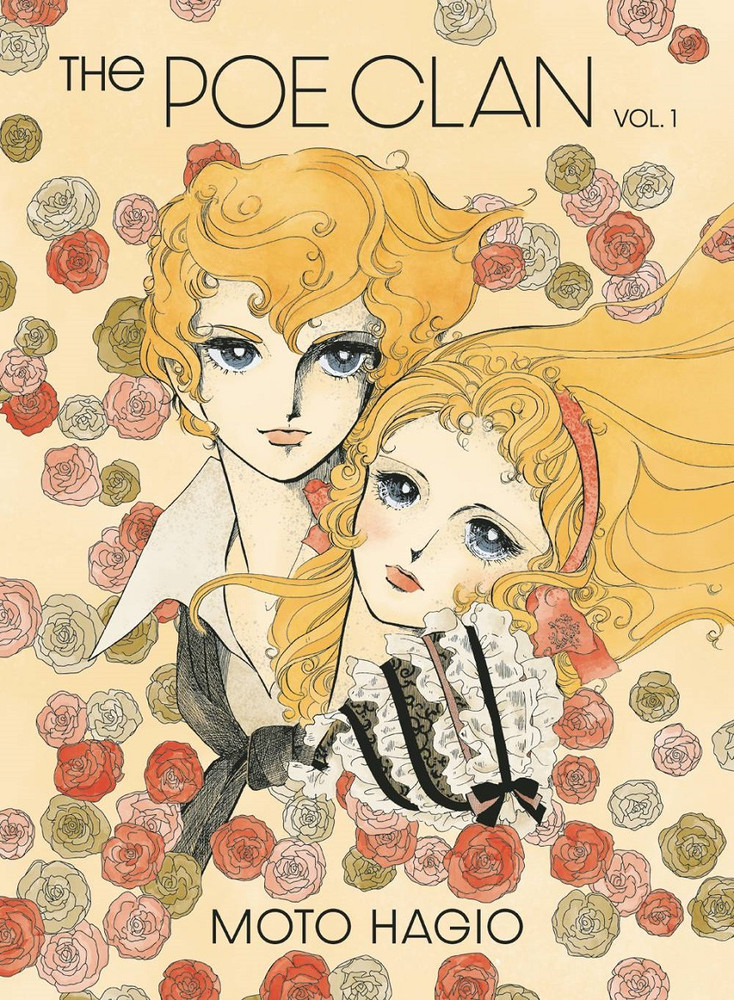By Moto Hagio. Originally released in Japan as “Poe no Ichizoku” by Shogakukan, serialized in the magazine Betsucomi. Released in North America by Fantagraphics. Translated by Rachel Thorn.
As with a lot of stories by Moto Hagio, it can be hard to describe how The Poe Clan works as a collected manga story because the reader has a tendency to get lost in the feel of it. Indeed, sometimes I got a bit too lost – the final story in the book, The Birds’ Nest, made me feel at times as if pages with important continuity had been removed to add to the impact. But of course the impact IS the point. This is especially clear in the first part of the book, which features the introduction of Edgar, his sister and Lost Lenore Marybelle, and Alan, the teenage boy who gets entangled in Edgar’s life and later becomes his companion. It actually reads like it was written after the later material (it may well have been – chronological publishing order is not required, especially in early manga collections) and has a lot more action and violence than the back half of the book, which relies on menace and mood. It’s hard to put down.
Oh yes, I haven’t mentioned, this is about a clan of vampires. Or vampirnellas, as they are referred to throughout the book. Edgar and Marybelle are adopted into the family, which tends to live its life on he run and trying to live like typical English aristocrats while not getting noticed. Unfortunately, Edgar is very good at getting noticed, being a gorgeous teenage boy and also having that brooding thing going on. His sister is also highly noticeable, but for the opposite reason – she is a ray of sunshine in everyone’s lives, causing even passing strangers to be mesmerized by her (or accidentally shoot her – you know how it is). Needless to say, her eventual fate, while not a surprise (with a cover like that, you aren’t expecting Edgar and Marybelle to have wacky adventures) hangs over the rest of the book, as well as most of Edgar’s actions. As for Alan, well, there are some homoerotic elements to their relationship, particularly in the final story, but Alan is so far not as good a character as the siblings.
The art is, as you’d expect, amazing. Flip to a random page and chances are you’ll find something that will have you staring. A possible exception to this are the ‘comedy’ elements of the final story, particularly the production of As You Like it, which has lots of goofy faces that help to alleviate the mood from the rest of the plot, which involves a seeming murder that may be a suicide and tortured young men in love. Much is made of the almost inhuman beauty of the vampirnellas, particularly Edgar, an no linework is spared in conveying that to the reader. This is absolutely a work you will want to keep on your shelf. (That said, the spine of my copy has “The Poe Clan” written from bottom to top, which contrasts sharply with most books in my collection, so use caution when shelving.)
The second and final volume of this series hasn’t been scheduled yet by Fantagraphics, but I hope to see it sometime next year. If only for more shots of brooding boys and gentle girls.


Yeah, on the note of the spine, it’s interesting that they chose to layout the spine in the European tradition (perhaps the cover designer was European and Fantagraphics didn’t notice this minor detail?
Looking forward to reading it, thanks for the review!
I was confused by that, as well–it doesn’t even match up with the other Hagio Fantagraphic Volumes (which are all of slightly different size, for some reason, but still look nice on a shelf together). Things like that drive me crazy!
Moto Hagio is my favourite, and I’m glad that–even with prolonged waits–Fantagraphics seem to remain committed to getting out her work (I’ve noticed Heart of Thomas, not to mention Drunken Dream, is long out of print and already going for quite a bit on Amazon marketplace). Series that can fit in two volumes seem to be ideal for them given their format and the wait between volumes (I doubt they’d touch it, but I’d suggest approaching an underrated work next–the 1980 Mesh, which is about 800 pages and, as Hagio has said many times, marks the clear “break” between phases in her style, art and story wise, too).
I own a three volume hardcover set of Poe from the ’90s (it’s padded out with various short stories that share similar themes and are from the same era). Anyway, it gives the date of serialization for each chapter or story–something I really wish Fantagraphics would have done too (it would be so easy to do…) Here they are (some do contradict, by a few months, what Rachel Thorn published in her bibliography of Hagio in that old Shoujo issue with the Hagio interview)…
Ch 1: 1/1972
Ch2: 5/1972
Ch3: 6/1972
Ch 4: 10/1972
Ch 5: 12/1973
Ch 6: 5/1973
Ch 7: 3/1975
Ch 8: 6/1975
Ch 9: 7/1975
Ch 10: 10/1975
Ch 11: 11/1974
Ch 12: 5/1975
Ch 13: 4/1975
Ch 14: 9/1975
Ch 15: 4/1976
So as you can see, they do jump around a bit (I believe this is the order they’ve always been published in–the initial tankoubons coming out some time after the serialization as shoujo takoubons weren’t as common back then. Unless they got some of the dates wrong (but the order of the first six chapters in Fantagraphics Vol 1, with chapter 6 actually being serialized before chapter 5.